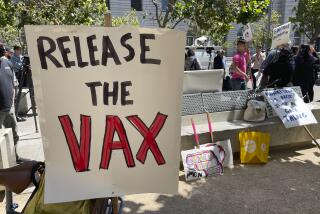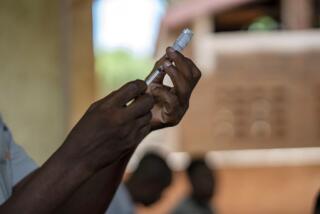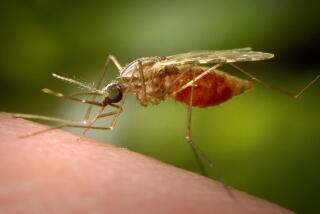Vaccines for Ebola and Marburg Show Promise
- Share via
U.S. and Canadian researchers have developed two vaccines that protect monkeys from the deadly Ebola and Marburg viruses, according to a study published Sunday.
Because humans and monkeys have similar immune systems, researchers are optimistic the vaccines will work in humans, said Steven Jones, a researcher at the Public Health Agency of Canada in Winnipeg and coauthor of the study.
There are no known cures for the two diseases, which cause high fever, massive bleeding and death for the vast majority of those infected. If the vaccines are found safe and effective for people, they could be approved for limited use in two to three years.
The study, published in the journal Nature Medicine, comes as the largest outbreak ever of Marburg hemorrhagic fever rages in Angola. So far, 335 people there have died from the disease, the World Health Organization said. An Ebola outbreak in the Republic of the Congo also has claimed nine lives in the last few weeks, the WHO said.
The vaccines were developed using genetic engineering techniques to insert selected Ebola and Marburg genes into a harmless virus. The altered virus replicated in test animals and produced proteins that stimulated a strong immune response.
Researchers at the U.S. Army Medical Research Institute of Infectious Diseases at Ft. Detrick, Md., injected cynomolgus macaques -- small, tree-dwelling monkeys -- with the vaccine for either Ebola or Marburg. Four weeks later, they were infected with one of the viruses.
None of the vaccinated monkeys died, nor did any become ill or suffer significant side effects.
“Any kind of vaccine for either one of these agents is exciting if it protects against a respectable challenge. And that certainly was a respectable challenge,” said Nancy K. Jaax, former chief of comparative pathology at Ft. Detrick.
Jones said the experimental vaccines showed promising results when given orally or as an aerosol to mice. Both forms would make administering the vaccines easier in areas with poor public health systems.
In unpublished experiments using mice, the vaccines also provided substantial protection when administered shortly after infection, Jones said.
“I’ve worked on Ebola and Marburg for 17 or 18 years and have watched failed study after failed study,” said Thomas Geisbert, a coauthor from the U.S. Army lab. “There’s no better feeling” than seeing healthy monkeys, he said.






